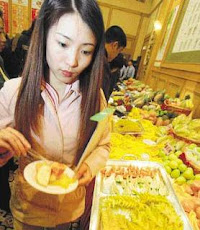Nyonya food, also referred to as Straits Chinese food or Lauk Embok Embok, is an interesting amalgamation of Chinese and Malay dishes thought to have originated from the Peranakan (Straits Chinese) of Malacca over 400 years ago. This was the result of inter-marriages between Chinese immigrants and local Malays, which produced a unique culture. Here, the ladies are called nyonyas and the men babas.
Nyonya food is also native to Penang and Singapore. However, over the years, distinct differences have evolved in nyonya cooking found in Penang and Singapore than that in Malacca. The proximity of Malacca and Singapore to Indonesia resulted in an Indonesian influence on nyonya food. Malacca Nyonyas prepare food that is generally sweeter, richer in coconut milk, and with the addition of more Malay spices like coriander and cumin. Meanwhile, the Penang Nyonyas drew inspiration from Thai cooking styles, including a preference for sour food, hot chilies, fragrant herbs, and pungent black prawn paste (belacan).
Influences aside, nyonya recipes are complicated affairs, often requiring hours upon hours of preparation. Nyonya housewives of the past would spend the better part of their lives in the kitchen, but they were fiercely proud of their unique cuisine, preferring nyonya food to any other type of food.
It has been said that in the old days, a Nyonya lady seeking a prospective bride for her son would listen to the pounding of spices by the maiden concerned as it denoted the amount of attention she would give to her cooking!
Nyonya cooking is also about the blending of spices, employing pungent roots like galangal, turmeric and ginger; aromatic leaves like pandan leaf, fragrant lime leaf and laksa leaf, together with other ingredients like candlenuts, shallots, shrimp paste and chilies. Lemon, tamarind, belimbing (carambola) or green mangoes are used to add a tangy taste to many dishes.
For dessert, fruits are seldom served and are instead replaced by cakes. Nyonya cakes are rich and varied, made from ingredients like sweet potato, glutinous rice, palm sugar, and coconut milk.
• Nyonya Assam Curry FishThe nyonya assam curry fish is cooked with assam jawa juice, shallots, garlic, lengkuas, buah keras, serai (lemon grass), buah kantan, daun kesom, chili boh, tumeric powder, belacan powder, chicken stock, and sugar. It is best served with steaming hot rice.
• Brinjal curryBrinjal is sliced and seasoned with tumeric powder (serbuk kunyit), dried prawns, roasted belacan (shrimp paste), and other spices. Served with hot rice and garnished with fried onions.
• PopiahThe basic ingredients are the same - shredded turnip, carrots, bean sprouts, cucumber, prawns, Chinese Taro, dried onion flakes, and garlic. However, the Nyonya popiah has the addition of a chili and sweet sauce made from palm sugar, wet spices, and a rice flour mixture that gives it a distinct taste. Egg is also added to the batter to give the popiah skin a moist texture.
• Nyonya Fried RiceUnlike other fried rice, the Nyonya Fried Rice is cooked with chopped dried shrimp, sliced mushrooms, hot pepper-soy sauce, chili powder, and shredded lettuce.
• Bubur cha-chaOne of the most popular Malaysian desserts is the bubur cha cha. It is cooked with yam, sweet potato, sago, pandan leaves, coconut milk, and block sugar.
• Ketam Lemak (Crabmeat)This dish is cooked in coconut milk, which makes the gravy mixture thick and sumptuous, and not forgetting the must-have spices.
• Udang Lemak NenasA popular dish, Udang Lemak Nenas is a mild prawn curry cooked with fresh pineapple cubes, coconut milk, and spices that includes coriander, star anise, and tumeric.
• Onde-ondeBasically glutinous rice balls rolled in freshly grated coconut, this is a dessert that is delicious yet fun to eat. At bite size, these balls are made by sealing a lump of chopped palm sugar (gula melaka) into a dessert spoonful of glutinous rice dough and then rolled into a ball. The fun comes when one savors the delicious feeling of oozing gula melaka syrup as you bite through the dough.
Source: http://www.marimari.com/content/malaysia/food/nyonya/nyonya1.html
Sunday, April 27, 2008
Subscribe to:
Post Comments (Atom)




No comments:
Post a Comment